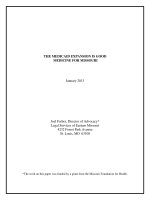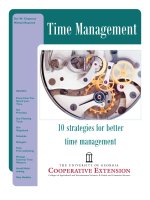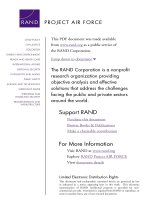Deming’s 14 Points for Management pptx
Bạn đang xem bản rút gọn của tài liệu. Xem và tải ngay bản đầy đủ của tài liệu tại đây (157.46 KB, 33 trang )
SAGE Notes
Deming’s 14 Points Page 1
Quality Management
Deming’s 14 Points for
Management
The Secret of Success is Constancy to Purpose.
Benjamin Disraeli
Speech [June 24, 1872]
SAGE Notes
Deming’s 14 Points Page 2
Deming’s Quality Chain Reaction
SAGE Notes
Deming’s 14 Points Page 3
Another view of the Quality Chain Reaction:
Improve
Quality
Costs decrease because
of less rework, fewer
mistakes, delays, snags;
better use of machine
time and materials.
Productivity
improves
Capture the
market with better
quality and lower
price
Stay inbusiness
Provide jobs and
more jobs
"So simple!"
(Deming)
SAGE Notes
Deming’s 14 Points Page 4
Deming's Fourteen Points for Management:
1 Create constancy of purpose for improvement of product
and services
2 Adopt the new philosophy
3 Cease dependence on mass inspection
4 End the practice of awarding business on price tag alone
5 Constantly and forever improve the systems of production
and services
6 Institute modern methods of training on the job
7 Institute modern methods of supervision and leadership
8 Drive out fear
9 Break down barriers between departments
10 Eliminate numerical goals for the work force
11 Eliminate work standards and numerical quotas
12 Remove barriers to pride of workmanship
13 Institute a vigorous programme of education and training
for everyone
14 Create a structure in top management that will push every
day on the above 13 points.
SAGE Notes
Deming’s 14 Points Page 5
Deming’s Fourteen Points for Management
1: Create Constancy of purpose toward
improvement of product and service, with the aim to
become competitive, stay in business, and provide jobs.
The essence of constancy of purpose is customer
orientation. - the answer to the question WHY?
Operational definition of customer needs is essential if
we are to meet those needs and expectations at a price
customers are willing to pay.
Essentials that top management must address:
• Establish policy
• Establish core values
• Set the long-term strategic course
Companies usually do have long-term vision, but have
short-term systems, that focus on short-term results.
The danger is that
“today’s short-term measures have long-
term impacts.” Peter Drucker
Top management may be on course, but the rest of the
company may be off somewhere doing their best.
“Doing your best is not good enough.
You have to know what to do. Then do
your best.”
W E Deming
SAGE Notes
Deming’s 14 Points Page 6
Constancy of purpose: Setting the course today to be in
business tomorrow.
The problem of management is maintaining consistency of
purpose: even when the aim is focused on the centre of the
target, if the rest of the company is off doing their best
without knowing what to do, results will not live up to
expectations.
Consistency of purpose: Striving to reduce the “spread”
around the course.
SAGE Notes
Deming’s 14 Points Page 7
2 Adopt the new philosophy. We are in a new economic
age, created by Japan. Western management must awaken to
the challenge, must learn their responsibilities, and take on
leadership for change.
Why?
What’s wrong with the old philosophy?
“Back to basics”?
The Japanese attention to TQM principles has created a new
economic age: the age of continuous improvement and systems
thinking.
The new age centres on the statement:
“Higher quality costs less, not more.”
Folklore:
Quality and productivity have an inverse relationship.
Quality
Quantity
Outmoded Relationship
SAGE Notes
Deming’s 14 Points Page 8
Ask the workers: “Why does productivity increase as quality
improves?”
Less rework
True relationship between quality and productivity:
Quality
Productivity
Modern view of Relationship
Improvement of process
leads to greater uniformity of product
reduces mistakes and rework
reduces waste of manpower, machine time, materials
increases output with lowered cost.
Other benefits:
better competitive position
happier people on the job
more jobs
improved morale
SAGE Notes
Deming’s 14 Points Page 9
Case study (from Deming’s consulting).
Problems with a certain process: lots of errors - why?
“Work force make a lot of mistakes.”
Hmmmm.
10
10.2
10.4
10.6
10.8
11
11.2
11.4
1 2 3 4 5 6 7 8 9 10 11 12 13 14 15 16
(Figures from inspection records - supervisor never looked at
them)
Should the supervisor know that this process is running at
11% defective?
What would the supervisor do if he did know that it was
11%?
SAGE Notes
Deming’s 14 Points Page 10
What is important to note here is that the process seems to be
in statistical control.
Therefore - system must change to improve. - Management
responsibility.
Deming - perhaps workers, and inspectors too, don’t
understand what kind of work is and is not acceptable.
Therefore - work on operational definitions.
Seven weeks later:
4
4.2
4.4
4.6
4.8
5
5.2
5.4
5.6
1 2 3 4 5 6 7 8 9 10 11 12 13 14 15 16
Results are obvious:
Quality is up
Production of good product is up 6%
Capacity is up 6%
Cost per unit of good product is lower
Profits are up
Customer is happier
Everybody is happier
SAGE Notes
Deming’s 14 Points Page 11
Meaningful change can only take place from within - focus on
the competition will not ensure survival.
Focus on the customer, not the competition.
3 Cease dependence on inspection to achieve quality.
Eliminate the need for inspection on a mass basis by building
quality into the product in the first place.
Recall our view of business systems as consisting of a large
number of interconnecting processes.
INPUTS
Suppliers
machines
material
methods
environment
measurement
Activity
Quality
Cost
responsiveness
OUTPUTS TO
CUSTOMERS
SAGE Notes
Deming’s 14 Points Page 12
Old way of doing business is to manage outcomes by detecting
defects:
Product
Inspection
Customer
(profit)
Rework
(loss)
Defect Detection
SAGE Notes
Deming’s 14 Points Page 13
Look at a typical inspection process:
FINISHED FILES ARE THE RESULT
OF YEARS OF SCIENTIFIC STUDY
COMBINED WITH THE
EXPERIENCE
OF MANY YEARS
(Count the F’s)
From this we learn:
Inspection doesn’t work!
Some defective product always gets through.
Some good product may also be classified as bad.
Even 200% inspection doesn’t work.
Detection of defects is not a viable competitive strategy.
A more modern view: Defect prevention, using both process
feedback and customer feedback.
People
Material
Equipment
Methods
Environment
People
Material
Equipment
Methods
Environment
People
Material
Equipment
Methods
Environment
Process
Feedback
Customer
Feedback
Action is on the
cause system
Key: understand variation.
SAGE Notes
Deming’s 14 Points Page 14
4 End the practice of awarding business on the basis of
price tag. Instead, minimise total cost. Move toward a single
supplier for any one item on a long-term relationship of
loyalty and trust.
Instead, require meaningful measures of quality along with
price.
Reduce the number of suppliers for the same item by
eliminating those that do not qualify with statistical evidence
of quality.
Move towards a single supplier for any one item, on a long-
term relationship of loyalty and trust.
The aim is to minimise total cost, not merely initial cost.
The real world, of course, is that often there is not a single
supplier who is able to provide the required quality, it may be
that there is not a single supplier who is good enough to be
trusted with the responsibility and privilege of becoming your
single supplier.
SAGE Notes
Deming’s 14 Points Page 15
Why do this? The short answer is: reduce variation.
Variation from one supplier is bad enough - the additional
variation caused by swapping from one supplier to another is
self-inflicted injury!
The objective here is a customer-supplier relationship, and is
an application of the "cooperation: win-win" philosophy.
The security of the long-term relationship allows the supplier
to innovate.
SAGE Notes
Deming’s 14 Points Page 16
5 Improve constantly and forever the system of production
and service, to improve quality and productivity, and thus
constantly decrease costs.
"Improve constantly and forever every
process for planning, production and
service. Search continually for problems in
order to improve every activity in the
company, to improve quality and
productivity and thus to constantly decrease
costs. It is management's job to work
continually on the system (design, incoming
materials, maintenance, improvements of
machines, training, supervision,
retraining)."
Some points to remember:
1 Putting out fires (tackling special causes) is not improving a
process. This is more in the line of obtaining a process in the
first place. We can say that we've got an established process
when the variation in the process is almost entirely common
cause variation - ie no special causes.
2 Emphasis on conformance to standards can obstruct
continuous improvement.
3 The Deming Cycle is key to continuous improvement:
PLAN
DO
CHECK
ACT
SAGE Notes
Deming’s 14 Points Page 17
6 Institute more thorough, better job-related training.
Institute modern methods of training on the job for all,
including management, to make better use of every employee.
“Statistical thinking will one day be as
necessary for efficient citizenship as the
ability to read and write.”
H G Wells
New skills are required to keep up with changes in materials,
methods, product design, machinery, techniques and service.
Note that training is for skills, unlike education, which is for
knowledge (Point 13).
Anyone, when he has brought his work to a state of statistical
control, whether he was trained well or badly, is in a rut. He has
completed his learning of that particular job. It is not economical
to try to provide further training of the same kind continuation
of training by the same method will accomplish nothing.
Inhibitors to training:
• It’s for my people, not for me.
• It’s for manufacturing, not for me.
• Our problems are different here.
• We rely on our experience.
• Hope for instant pudding.
• People learn in different ways.
Management cannot intelligently change company systems
without an understanding of statistical thinking.
SAGE Notes
Deming’s 14 Points Page 18
7 Institute Leadership. The aim of leadership should be to
help people, machines and gadgets to do a better job.
Supervision of management is in need of overhaul, as well as
supervision of production workers.
Adopt and institute leadership aimed at helping people to do a
better job.
The responsibility of managers and supervisors must be
changed from sheer numbers to quality.
Improvement of quality will automatically improve
productivity.
Management must ensure that immediate action is taken on
reports of inherited defects, maintenance requirements, poor
tools, fuzzy operational definitions, and other conditions
detrimental to quality.
SAGE Notes
Deming’s 14 Points Page 19
Some quotes from Deming:
"A LEADER'S JOB IS TO HELP
PEOPLE AND TO KNOW WHEN
PEOPLE NEED SPECIAL HELP. HE
IS NOT A LEADER UNLESS HE
DOES KNOW ".
"IF A WORKER CANNOT LEARN
HIS JOB, WHY DID YOU PUT HIM
THERE?"
"I USED TO SAY THAT PEOPLE
ARE ASSETS, NOT COMMODITIES.
BUT THEY ARE NOT JUST ASSETS:
THEY ARE JEWELS".
"WHY LEAD? PEOPLE HAPPIER,
QUALITY UP, PRODUCTIVITY UP,
EVERYBODY WINS"
SAGE Notes
Deming’s 14 Points Page 20
8 Drive out fear, so that everyone may work effectively for
the company.
Encourage effective two-way communication and other means
to drive out fear throughout the organisation so that
everybody may work effectively and more productively for
the company.
Fear is a barrier to improvement: wherever there is fear, we
get the wrong figures.
Fear in work is opposite to joy in work.
Fear of change is a big barrier to be overcome: remember,
people don’t resist change, they resist being changed! The
need is for everybody to be part of the change, and to own the
change process.
Some common expressions of fear:
I am afraid that I may lose my job because the company will go out of
business.
I have a feeling that Dave (higher up) may move to another company.
If he does, what will happen to me?
I could do my job better if I understood what happens next.
I am afraid that I may not always have an answer when my boss asks
me something.
I am afraid to admit that I made a mistake.
SAGE Notes
Deming’s 14 Points Page 21
My boss believes in fear. How can he manage his people if they don’t
hold him in awe? Management is punitive.
Without an atmosphere of mutual respect, no statistically
based system of management will work, nor any other.
Deming always says that this point is one of the most
important for management to work on, because it affects nine
of the other points:
break down departmental barriers
cease dependence on mass inspection
institute education and training
institute training
eliminate slogans and exhortations
end awarding business on price-tag
eliminate work standards
continuous improvement
remove barriers
Remember: an atmosphere of fear results in management
getting a “filtered” view of the organisation.
SAGE Notes
Deming’s 14 Points Page 22
9 Break down barriers between departments. People in
research, design, sales, and production must work as a team
to foresee problems of production and in use that may be
encountered with the product or service.
Barriers breed suboptimization.
This is the direct opposite to the Joiner Triangle's 'All One
Team' and Deming's 'Win-Win' principle.
Deming says quite bluntly that if the boss of every staff area
perceives (or indeed is told) that his objective is to maximize
his department's profits then the company will fail.
One of the most crucial differences between old-style and
new-style management is seen in the way that shop-floor
employees, supervisors, departments, middle-managers and
senior managers regard their job: is it to suboptimize, or is it
to work for the company?
It cannot be both.
Incidentally, Deming points out that one clear symptom of the
suboptimization mode is proliferation of paperwork, resulting
in considerable inefficiency, irritation and cost.
He quotes studies showing that 14% of freight charges are
spent on paperwork, the figure in motor freight, in particular,
being more like 20%.
SAGE Notes
Deming’s 14 Points Page 23
10 Eliminate slogans, exhortations and targets for the work
force that ask for zero defects and new levels of productivity.
Such exhortations only create adversarial relationships; the
bulk of the causes of low quality and low productivity belong
to the system, and thus lie beyond the power of the workforce.
What can be wrong with slogans? a few posters?
Indeed, surely posters can give useful and helpful
information? Surely, slogans are useful to jog the memory on
important matters, and thus aid greater commonality of
thought and aims?
The argument is directed at those who simply tell (exhort)
others to do better without helping them in any way so to do.
It demonstrates ignorance or disbelief of the fact that the
large majority of problems lie in the system, the responsibility
of management, rather than with the workers at whom the
posters and slogans are aimed.
SAGE Notes
Deming’s 14 Points Page 24
Deming:
“Posters that explain to everyone on the job
what the management is doing month by
month to (for example) purchase better
quality of incoming materials from fewer
suppliers, better maintenance, or to provide
better training, or statistical aids and better
supervision to improve quality and
productivity, not by working harder but by
working smarter, would be a totally
different story: they would boost morale.
People would then understand that the
management is taking some responsibility
for hang-ups and defects, and is trying to
remove obstacles”
SAGE Notes
Deming’s 14 Points Page 25
11 Eliminate work standards (quotas) on the factory floor.
Substitute leadership. Eliminate management by objective.
Eliminate management by numbers, numerical goals.
Substitute leadership
Eliminate work standards that prescribe numerical quotas for
the workforce and numerical goals for people in management.
Substitute aids and helpful leadership; statistical methods for
continual improvement of quality and productivity.
No, Deming is not telling us to manage without numbers!
And, of course, both companies and individuals need goals,
intentions, and aims - but not in isolation; they need the
education, training, systems and methods to make it
reasonable for these to be attained. What they do not need is
arbitrary numerical goals. Of course, a company needs
budgets and forecasts for planning and allocation of
resources—but they must also not be arbitrary numerical
goals, nor must they become such.









